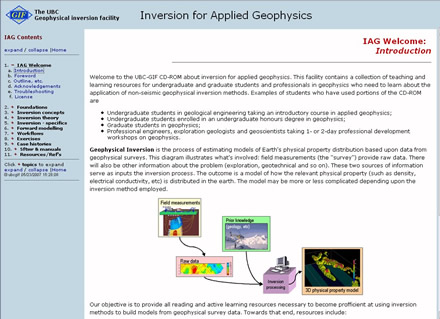IAG
The UBC-GIF IAG package of resources is a teaching and learning facility for undergraduate and graduate students and professionals in geophysics who need to learn about the application of non-seismic geophysical inversion methods. Instructions for obtaining the package are below.
The focus is on potential fields methods (gravity and magnetics), DC resistivity and induced polarization. Documentation for modelling and inversion codes for electromagnetic data are part of the package, but in this first version of IAG there are few other resources related EM methods. Seismic reflection and refraction are rarely mentioned.
 |
Objectives and Outline
The objective is to provide all reading and active learning resources necessary to become proficient at using inversion methods to build models from geophysical survey data. The eleven chapters are organized as follows:
- Welcome: Foreword, Getting Started, etc.
- Foundations: Introductions to essential concepts underlying applied geophysics, including a generally applicable framework for applying geophysics, and sections about physical properties and geophysical surveys (magnetics, gravity, DC resistivity and Induced Polarization).
- Inversion concepts: Explains what inversion is, how it works (minimal mathematics), and outlines how to judge whether a problem might benefit from the use of geophysical inversion.
- Inversion theory: An explanation of how inversion works at a level appropriate for senior undergraduate students in geophysics, math or physics.
- Inversion - specifics: Aspects of inversion theory that are specific to DC resistivity, induced polarization (IP), magnetic or gravity data (via the original software documentation).
- Forward modelling: Fundamental theory underlying the calculation of data when the earth model is known. The sections are adapted from background theory chapters of user manuals written for UBC-GIF inversion codes.
- Workflows: Recommended sequences of actions for inverting specific data types. These are basically carefully designed instructions for using UBC-GIF codes in as effective and efficient a manner as possible.
- Exercises: (Details) A collection of exercises providing opportunities for students to practice using codes, or aspects of inversion. Where appropriate, the activities include data, models, programs, and real scenarios.
- Case Histories: Examples showing how geophysical inversion has contributed to many mineral exploration and engineering / environmental applications.
- Software and manuals: Access to educational versions of forward modelling and inversion codes (MAG3D, GRAV3D, DCIP2D), utility codes, applets, and all relevant documentation.
- Resources: Other facilities including a FLASH™-based Learning Object about applied geophysics (TAGFLO), a glossary, references, and others.
Obtaining the IAG resource package
The package is distributed via flintbox, a global intellectual property exchange. You will need a high speed internet connection, a current browser (Microsoft I.E. or Mozilla Firefox are recommended), and at least 150Mbytes of free space on a computer running a Windows-based operating system. To download the IAG resource package at no charge from flintbox:
1. Visit ubc.flintbox.com
2. Search for “IAG”. Find and select the tile for the "Inversion for Applied Geophysics (IAG): a Resource Package for Learning About Geophysical Inversion"
3. Scroll down to the end of the page and under Offerings, buy at no charge (free)
4. Provide a name and email and agree to the licensing. On the following page, you will be able to download a zip file containing the setup executable.
5. Unzip the file and run the setup executable
The total space required for the package is 220MB. The setup takes less than 5 minutes on a high speed internet connection.


.png)